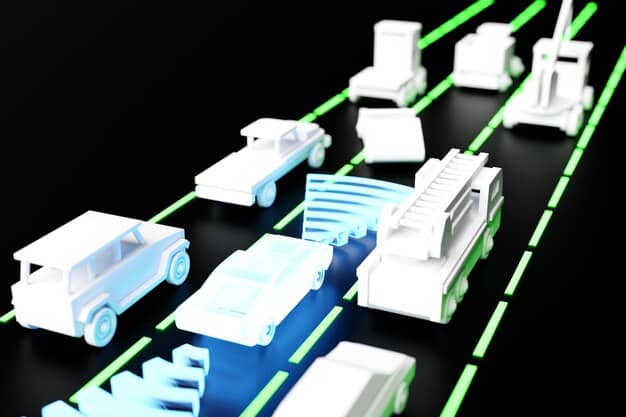US Military Embraces Blockchain for Secure Data Transmission

The US military is actively exploring and integrating blockchain technology to enhance secure data transmission, leveraging its decentralized and immutable ledger capabilities to protect sensitive information from cyber threats and ensure data integrity across complex operational environments.
The landscape of modern warfare is increasingly digital, and with it comes the formidable challenge of securing critical information. In this evolving domain, the question of How is the US Military Integrating Blockchain Technology for Secure Data Transmission? is no longer theoretical but a pressing operational imperative. Blockchain, a technology synonymous with cryptocurrencies, is demonstrating its potential far beyond finance, offering a robust framework for unparalleled data security and integrity within defense operations.
The Imperative for Enhanced Data Security in Defense
The United States military operates within an extremely complex and interconnected global environment where information is a critical asset. Ensuring the confidentiality, integrity, and availability of this data is paramount, particularly given the constant threat of sophisticated cyberattacks from state and non-state actors. Traditional cybersecurity measures, while robust, face limitations in distributed networks and highly dynamic operational settings. This drive for superior data protection is pushing defense agencies to explore innovative solutions.
Challenges of Traditional Data Transmission
Conventional data transmission methods often rely on centralized servers or single points of control, creating attractive targets for adversaries. If a central database is compromised, the entire system can be jeopardized. Furthermore, verifying the authenticity and integrity of data across various geographically dispersed units in real-time presents significant logistical and technological hurdles.
- Centralized Vulnerabilities: Single points of failure make systems susceptible to large-scale data breaches.
- Lack of Immutability: Data can potentially be altered or tampered with without immediate detection, compromising trust.
- Latency and Scalability: Securely transmitting vast amounts of data across diverse networks can suffer from bottlenecks.
- Interoperability Issues: Different systems and agencies often struggle to share data seamlessly and securely.
Why Blockchain Emerges as a Solution
Blockchain’s foundational principles—decentralization, immutability, and cryptographic security—make it a compelling candidate for military applications. By distributing data across a network of nodes, it eliminates single points of failure. Every transaction or piece of data recorded on the blockchain is cryptographically linked to the previous one, forming an unchangeable ledger. This inherent immutability provides a virtually tamper-proof record, critical for sensitive military intelligence and operational directives.
To address the ever-growing threat landscape, the military has shifted its focus towards proactive and resilient cybersecurity architectures. This means not just protecting data, but building systems that can withstand and recover from attacks, ensuring continuous operations even under duress. Blockchain, by its very design, offers a distributed resilience that is appealing in such high-stakes environments. The integration promises a paradigm shift in how information is managed and secured from the tactical edge to strategic command centers.
Foundational Concepts: How Blockchain Powers Secure Military Operations
At its core, blockchain is a distributed ledger technology that records transactions in a secure, transparent, and unchangeable way. For military applications, this translates into an unprecedented level of data integrity and resistance to tampering. Each “block” contains a timestamped batch of valid transactions, and once recorded, it’s virtually impossible to alter the data without detection. This is achieved through cryptographic hashing and linking blocks together.
Decentralization and Immutability in Practice
In a decentralized blockchain network, there is no single central authority that controls the data. Instead, copies of the ledger are replicated and maintained across multiple participating nodes. This distribution means that even if several nodes are compromised, the integrity of the overall ledger remains intact, as consensus mechanisms ensure that only validated, identical copies persist across the network. For the military, this decentralization offers a crucial layer of resilience against coordinated cyberattacks aimed at disrupting information flow.
The immutability aspect is particularly valuable for sensitive military data. Once a piece of intelligence, a logistical record, or a command is recorded on the blockchain, it cannot be retroactively changed or deleted. This creates an indisputable audit trail, crucial for accountability, forensics, and maintaining the accuracy of critical historical data. Imagine the implications for supply chain management, where the provenance of every component can be tracked with absolute certainty, eliminating counterfeits and ensuring the integrity of equipment.
Cryptographic Security and Data Privacy
Beyond decentralization and immutability, blockchain employs advanced cryptographic techniques to secure information. Public-key cryptography is used to verify the authenticity of participants and transactions. Data stored on the blockchain can be encrypted, ensuring that only authorized parties with the correct decryption keys can access the sensitive content, even though the transaction record itself is visible on the distributed ledger. This selective access control is vital for military applications where different levels of clearance and need-to-know principles apply.
This combination of features positions blockchain as a superior alternative for securing data transmission across various military domains. It moves beyond traditional perimeter-based security, which often focuses on preventing external breaches, towards a far more robust, intrinsic data security model. Understanding these foundational concepts is key to grasping the transformative potential of blockchain within the defense sector. The ability to create unalterable records, resilient networks, and cryptographically secured communications offers a powerful edge in maintaining information superiority on the modern battlefield.
Current Implementations and Pilot Programs in the US Military
The exploration of blockchain by the US military is not merely theoretical; several agencies and branches are actively engaged in pilot programs and research initiatives to test and integrate this technology. These efforts span various applications, demonstrating the versatility of blockchain beyond its common association with financial transactions. The aim is to move from proof-of-concept to operational capability, addressing specific pain points in existing systems.
Logistics and Supply Chain Management
One of the most promising areas for blockchain application in the military is logistics and supply chain management. The Department of Defense (DoD) manages an incredibly complex global supply chain for everything from munitions and spare parts to food and medical supplies. Ensuring the authenticity and origin of these items is critical, especially given the prevalence of counterfeit parts which can compromise operational readiness and safety.

Blockchain’s immutable ledger can track every component from its manufacturer to its final destination, providing an unalterable record of its provenance, maintenance history, and chain of custody. This transparency can significantly reduce fraud, improve efficiency, and ensure that only genuine, quality-controlled parts are deployed. Projects are exploring how to use blockchain to secure the entire lifecycle of a component, from initial production to decommissioning, ensuring trust and traceability at every step.
Secure Communications and Data Sharing
Another vital application lies in securing military communications and facilitating secure data sharing between different units, agencies, and even allied forces. Traditional communication channels can be vulnerable to eavesdropping or data manipulation. Blockchain can create highly resilient and cryptographically secured communication networks where messages are immutably recorded and their authenticity can be instantly verified.
The Defense Advanced Research Projects Agency (DARPA) has been particularly interested in blockchain for secure, decentralized messaging platforms that can operate in contested environments, resilient to denial-of-service attacks. Moreover, it holds potential for secure intelligence sharing, where sensitive information can be distributed and accessed by authorized personnel across a distributed network, without relying on a single, vulnerable server. This enhances situational awareness and decision-making by ensuring the integrity and timeliness of shared intelligence.
Identity Management and Personnel Security
Beyond data and supply chains, the military is also exploring blockchain for enhanced identity management and personnel security. Managing clearances, access control, and personnel records for millions of service members and contractors is a monumental task. Blockchain can provide a secure, decentralized system for managing digital identities, streamlining the verification process and reducing the risk of identity theft or unauthorized access.
This can be particularly useful for granting temporary access to facilities or systems, where a verifiable, temporary credential can be issued and revoked almost instantly. The distributed nature of the ledger would also make it much harder for adversaries to compromise the entire identity management system, as no single database holds all the information. The pilots are proving that blockchain is flexible enough to adapt to the highly specific and demanding requirements of military operations, from the strategic level down to the tactical edge.
Challenges and Limitations in Blockchain Adoption
While the potential of blockchain technology for military applications is significant, its widespread adoption is not without considerable challenges. The unique operational environment and stringent security requirements of the defense sector introduce complexities that may not be present in commercial applications. Addressing these limitations is crucial for successful integration.
Scalability and Performance Issues
One of the primary challenges for blockchain in high-volume military data environments is scalability. Traditional public blockchains, like Bitcoin or Ethereum, are known for their relatively low transaction throughput compared to centralized databases. Military operations generate vast amounts of data in real-time, from sensor readings and intelligence feeds to logistical updates. Ensuring that a blockchain network can handle this immense volume of transactions, without introducing significant latency or processing delays, is a formidable technical hurdle.
Private or permissioned blockchains can offer better scalability than public ones, as they involve a limited number of known participants and can optimize consensus mechanisms. However, even these tailored solutions require rigorous testing and optimization to meet military performance standards. Research is actively ongoing to develop more efficient consensus algorithms and sharding techniques to enable blockchains to process millions of transactions per second, a necessity for some defense applications.
Interoperability with Legacy Systems
The US military relies on a vast and complex ecosystem of legacy IT systems, many of which have been in operation for decades. Integrating nascent blockchain technology with these older, often proprietary, systems presents a significant interoperability challenge. Data formats, communication protocols, and security standards vary widely, making seamless data exchange difficult. This “digital debt” can slow down the adoption of new technologies.
Developing middleware or integration layers that can translate between blockchain networks and existing systems is critical. This requires extensive engineering effort and careful planning to avoid disrupting ongoing operations. Furthermore, the cultural and organizational inertia associated with moving away from established systems can also be a barrier, necessitating careful change management strategies.
Regulatory and Policy Hurdles
The legal and regulatory framework surrounding blockchain technology is still evolving, even in the commercial sector. For the military, adapting existing policies and establishing new ones for blockchain deployment is a complex undertaking. Issues such as data ownership, chain of command in decentralized networks, cryptographic export controls, and compliance with various defense regulations (e.g., NIST, FedRAMP requirements) need to be carefully addressed.
Furthermore, defining clear legal responsibilities and accountability in a decentralized system can be challenging. Who is responsible if a smart contract execution goes awry or if a blockchain-based system fails? These questions require robust legal and policy guidance to ensure that blockchain solutions operate within established military norms and regulations, while still leveraging the technology’s full potential. Overcoming these hurdles requires a collaborative effort between technologists, policymakers, and legal experts within the defense establishment.
Future Outlook: Expanding Blockchain Across Defense Sectors
The trajectory of blockchain integration within the US military points towards a broad expansion beyond current pilot programs. As the technology matures and current challenges are addressed, its application is likely to permeate more facets of defense operations, fundamentally reshaping how information is secured, managed, and utilized. The strategic vision is to leverage blockchain for a more resilient, efficient, and secure military infrastructure.
Decentralized Autonomous Organizations (DAOs) for Command Structures
One futuristic, yet increasingly discussed, application is the concept of leveraging Decentralized Autonomous Organizations (DAOs) or similar blockchain-based governance models for certain command and control functions. While a full transition to DAOs for core military leadership is unlikely, elements of decentralized decision-making could enhance responsiveness and resilience in specific scenarios. Imagine secure “smart contracts” automating logistical deployments based on verified sensor data, or decentralized consensus mechanisms for approving specific, rule-based operations.
Cyber Warfare and Defense Applications
Blockchain’s inherent cryptographic security and immutability make it a potent tool in cyber warfare, both for defense and potentially for offensive operations. For defense, it could create tamper-proof logs of network activity, providing unparalleled forensic capabilities to identify and trace cyberattacks. It could also power self-healing network segments, where compromised nodes are automatically isolated and replaced, maintaining operational continuity. The ability to verify the integrity of software and firmware updates through a blockchain can also prevent supply chain attacks targeting critical military systems.
Interagency and Coalition Data Sharing
Beyond internal military applications, blockchain holds immense promise for secure interagency and coalition data sharing. Sharing sensitive intelligence and operational plans with allied nations and various US government agencies (e.g., CIA, NSA, DHS) is fraught with security risks and interoperability issues. A permissioned blockchain could provide a highly secure and auditable platform for such exchanges, enabling partners to share data selectively while maintaining cryptographic control and an immutable record of access and usage. This could significantly improve multi-national operational effectiveness.
The future integration of blockchain will likely involve a phased approach, starting with non-critical systems and gradually moving towards more central applications as confidence and technological maturity grow. This long-term vision positions blockchain not just as a technology upgrade, but as a foundational element of future military cybersecurity and information superiority strategies. The emphasis will remain on ensuring absolute security, unprecedented data integrity, and operational resilience in an ever-evolving threat landscape.
Strategic Implications for National Security
The successful integration of blockchain technology by the US military carries profound strategic implications for national security, extending far beyond tactical advantages. It represents a fundamental shift in how the nation will approach information warfare, cybersecurity, and global defense posture. This technological leap enables a robust and resilient framework capable of withstanding sophisticated threats.
Enhancing Information Superiority
Information superiority is a cornerstone of modern military doctrine. It refers to the ability to collect, process, and disseminate an uninterrupted flow of information while simultaneously denying the adversary the ability to do the same. Blockchain directly contributes to this by providing a highly secure and verifiable information environment. By ensuring data integrity and authenticity, it sharpens the accuracy of intelligence, improves the reliability of sensor data, and strengthens the chain of command. This enhanced trust in information translates directly into better decision-making on the battlefield and in strategic planning.
Deterring Cyber Adversaries
The deployment of blockchain-based security solutions can serve as a powerful deterrent to cyber adversaries. Knowing that military networks and data are protected by a decentralized, immutable, and cryptographically secure ledger makes it considerably harder and riskier for malicious actors to attempt data breaches, tampering, or denial-of-service attacks. The increased difficulty and expense of compromising such systems diminish the probability of successful attacks, thus bolstering overall national security. It forces adversaries to expend greater resources and face higher risks for marginal gains.
Strengthening Alliances and Partnerships
As discussed, blockchain can facilitate secure and verifiable data sharing with allies. This capability transcends mere technical convenience; it strengthens military alliances and partnerships by fostering greater trust and interoperability. When allies can confidently share sensitive information on a shared, immutable ledger, it enhances joint operational planning, intelligence sharing, and overall coalition effectiveness. This shared technological foundation can also streamline joint logistics, humanitarian aid, and disaster relief efforts, solidifying international cooperation in times of crisis.
Ultimately, the strategic implications of blockchain in military applications are about creating a more secure, resilient, and adaptive defense force for the 21st century. It’s about building a digital infrastructure that reflects the distributed nature of modern threats and global operations. By embracing this technology, the US military aims to not only protect its assets but also maintain its technological edge, ensuring enduring national security in an increasingly digitized world. The successful integration of blockchain technologies will play a pivotal role in shaping future defense capabilities and international relations.
Overcoming Data Privacy Concerns and Ethical Considerations
While blockchain promises enhanced security, its application in military contexts, especially concerning sensitive data transmission, inevitably raises significant data privacy and ethical considerations. Balancing the need for transparency and immutability with the imperative for secrecy and protection of classified information is a delicate act.
Balancing Transparency with Secrecy
One of blockchain’s core tenets, transparency, can be a double-edged sword for military applications. While the immutability of records is desirable for auditability and integrity, the visibility of all transactions (even if encrypted) on a public ledger is clearly unacceptable for classified military operations. The solution lies in the deployment of “permissioned” or “private” blockchains, where participation is restricted and access to specific data can be highly controlled through stringent access permissions and zero-knowledge proofs. These allow verification without revealing underlying sensitive information.
The challenge then becomes ensuring that these private networks still retain the core benefits of decentralization and immutability without succumbing to the single points of failure found in traditional centralized systems. This involves careful design of network configurations and consensus mechanisms to prevent collusion among a limited number of nodes. The focus shifts from public visibility to verifiable privacy, where data is encrypted but its integrity and origin are still provable.
Ethical Deployment and Data Governance
The ethical implications of immutable military records, especially concerning actions in conflict zones or personnel conduct, are substantial. An unalterable ledger of events could provide unprecedented accountability but also raises questions about the right to be forgotten (if applicable), the potential for misuse of historical data, and the balance between operational necessity and individual rights. Establishing clear data governance policies and ethical guidelines for blockchain use in the military is paramount.
This involves defining:
- Data Retention Policies: How long will data be kept on the blockchain, and under what conditions?
- Access Control Protocols: Who can access specific types of data, and how are these permissions managed and revoked?
- Dispute Resolution: Mechanisms for addressing errors or disputes within immutable records.
- Compliance with International Law: Ensuring blockchain applications adhere to laws of armed conflict and human rights conventions.
These considerations require a consultative approach involving legal experts, ethicists, and military strategists to ensure that the technological advancements align with foundational values and international norms. The goal is to maximize the security and operational benefits of blockchain while rigorously upholding privacy, accountability, and ethical principles, ensuring that this powerful technology serves its intended purpose of enhancing national security responsibly.
| Key Aspect | Brief Description |
|---|---|
| 🛡️ Data Security | Blockchain offers immutable, decentralized records, enhancing data integrity and resilience against cyberattacks. |
| 📦 Logistics & Supply Chain | Provides end-to-end traceability of components, reducing fraud and ensuring authenticity of military goods. |
| 💬 Secure Communications | Enables cryptographically secured, resilient communication networks resistant to tampering and eavesdropping. |
| ⚙️ Challenges & Future | Addresses scalability, legacy system integration, and regulatory hurdles for broader future defense applications. |

Frequently Asked Questions About Blockchain in the US Military
Blockchain’s primary benefit is its ability to create an immutable, decentralized, and cryptographically secure ledger of data. This significantly enhances data integrity, authenticity, and resilience against cyber threats, eliminating single points of failure common in traditional centralized systems and providing an unalterable audit trail for all recorded information.
Blockchain improves military supply chain security by providing end-to-end traceability for components. Every step, from manufacturing to delivery, is recorded on an immutable ledger. This verifiable history helps prevent counterfeit parts, ensures provenance, and increases transparency, significantly reducing fraud and enhancing the overall integrity of military equipment and supplies.
Yes, significant challenges include scalability issues, as military operations generate vast amounts of real-time data, requiring high transaction throughput. Interoperability with existing legacy systems also poses difficulties. Additionally, developing clear regulatory frameworks and addressing inherent privacy concerns while maintaining necessary secrecy are crucial hurdles for widespread adoption.
Absolutely. Blockchain can create highly resilient and cryptographically secured communication networks. Messages can be timestamped and immutably recorded, making them resistant to tampering and eavesdropping. This ensures the authenticity and integrity of critical commands and intelligence shared between units, enhancing operational awareness and decision-making in contested environments by minimizing communication vulnerabilities.
The future outlook is promising, with a likely expansion into areas like advanced identity management, cyber warfare defense, and secure interagency data sharing. As the technology matures, it’s expected to become a foundational component of future military cybersecurity and information superiority strategies, contributing to a more resilient, efficient, and secure defense infrastructure against evolving global threats.
Conclusion
The exploration and integration of blockchain technology by the US military underscore a proactive approach to enhancing national security in the digital age. From safeguarding critical supply chains to securing sensitive communications and managing complex data flows, blockchain offers a transformative paradigm for data integrity and resilience. While challenges related to scalability, interoperability, and policy remain, the inherent strengths of decentralization, immutability, and cryptographic security position blockchain as an indispensable tool for future defense operations, solidifying information superiority and deterring adversaries in an increasingly complex global landscape.





